by C. Elkins, OK Math and Reading Lady
Starting in 3rd grade, students start using words and symbols to read and write fractions (Oklahoma Academic Standards OAS 3.N.3.1), construct fractions (3.N.3.2), compose and decompose them (3.N.3.3), and order and compare them using models and number lines (3.N.3.4). Fourth and Fifth graders continue to refine these skills. In this post, I will address different ways to compare fractions (keeping in mind the concrete-pictorial-abstract progression) by comparing numerators, comparing denominators, comparing to half, and utilizing knowledge of unit fractions. Students should have extensive experience utilizing models such as fraction strips, fraction circles, pattern blocks, number lines, pictures, and drawings to help build the concepts of fractional parts before being asked to put a <, >, or = sign between two fractions. See the end for a FREE comparing fractions guide.
 In my opinion, determining if (or how) two fractions are equivalent is also a very important step when comparing fractions. However, regarding the OAS, students are not asked to represent or rename equivalent fractions until 4th grade (4.N.2.1). I will address equivalent fractions in the next post – just know that sometimes this skill goes hand in hand with comparing fractions. AND keep in mind that most of the standards for fractions through 4th grade stipulate “using concrete and pictorial models, fraction strips, number lines.” Students in 4th grade should not be expected to do abstract paper-pencil steps to simplify or “reduce” fractions to simplest terms, nor cross multiply to compare, etc. They need hands-on experience to more fully understand the concepts about fractions that are so difficult to grasp abstractly. Then in 5th grade students should have enough visual pictures in their head to solve operational problems with fractions. OK, that’s my soapbox. Don’t make it harder than it should be.
In my opinion, determining if (or how) two fractions are equivalent is also a very important step when comparing fractions. However, regarding the OAS, students are not asked to represent or rename equivalent fractions until 4th grade (4.N.2.1). I will address equivalent fractions in the next post – just know that sometimes this skill goes hand in hand with comparing fractions. AND keep in mind that most of the standards for fractions through 4th grade stipulate “using concrete and pictorial models, fraction strips, number lines.” Students in 4th grade should not be expected to do abstract paper-pencil steps to simplify or “reduce” fractions to simplest terms, nor cross multiply to compare, etc. They need hands-on experience to more fully understand the concepts about fractions that are so difficult to grasp abstractly. Then in 5th grade students should have enough visual pictures in their head to solve operational problems with fractions. OK, that’s my soapbox. Don’t make it harder than it should be.
Materials to use: pattern blocks, fraction strips, fraction circles, cubes, tiles, two-color counters, Cuisenaire rods, number lines, paper plates, graham crackers, candy (m and m’s, skittles, etc.)
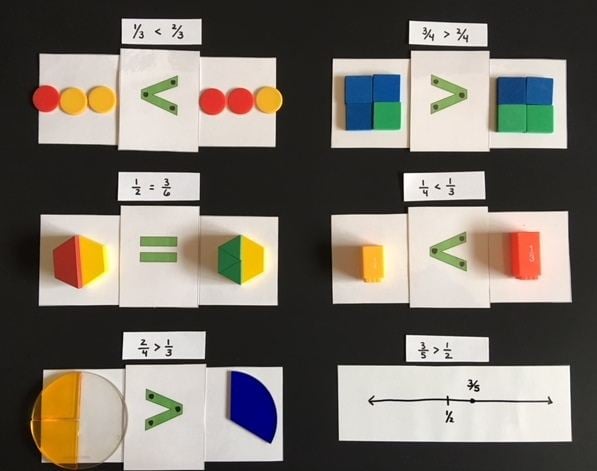
Ways to Compare (when using same size wholes – you can’t compare 3/4 of a donut with 1/2 of a birthday cake):
- Using unit fractions: If the fraction is a unit fraction, it has a 1 as a numerator. This should form the first type of comparison: 1/2 > 1/3 and 1/5 < 1/4 and 1/6 > 1/10, etc. This type of comparison is critical to fractional understanding.
- Same denominator: When the denominators are the same, then compare the numerators. 2/4 > 1/4.
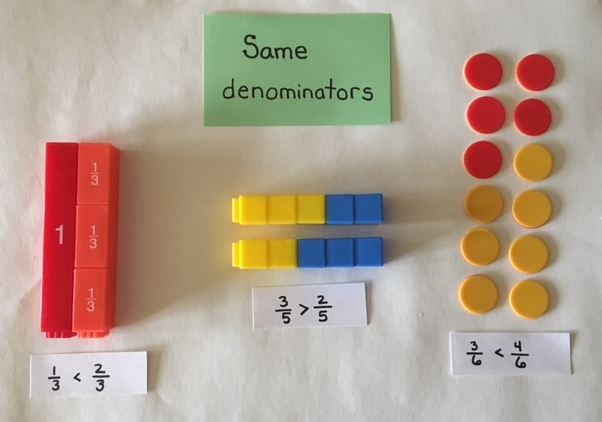
- Same numerator: When the numerators are the same, compare the denominators. For example: When comparing 2/5 with 2/10, since fifths are larger parts than tenths, 2/5 will be larger than 2/10. This is hard for some students to think about, because the smaller the number designated for the denominator, the larger the part (when comparing the same size whole).

- Unit fractions one away from the whole: These are fractions in which there is one unit to be added to make it a whole (1). The numerators of these fractions will be one less than the denominator. 11/12 is 1/12 away from the whole (1). 7/8 is 1/8 away from the whole (1). Example: To compare 3/4 with 5/6, use manipulatives or a number line to see that 3/4 is 1/4 away from 1, while 5/6 is 1/6 away from 1. Since 1/4 is a bigger part than 1/6, then 3/4 < 5/6.
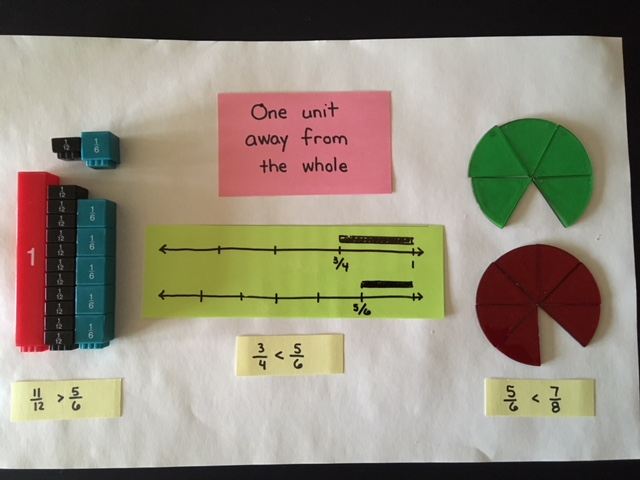
- Less than half? More than half? Learn all of the fractions that equal half. While this might sound simple, students often have misconceptions that 1/2 is the only way to describe half, or that a 5 must be in the fraction to be half (because 5 is the midpoint when used on a number line for rounding). I ask students to recall their addition facts dealing with doubles from 2nd grade. Since 2 + 2 = 4, two is half of 4, and 2/4 = 1/2. Repeat that with other forms of 1/2. Students should learn that finding half of an even-numbered denominator should be figured quickly (7/14, 9/18, 25/50, 50/100, etc.). Then use knowledge of half to determine if a fraction is less than half or more than half. Since 7/14 = 1/2, then I know that 6/14 < 1/2 and 9/14 > 1/2.
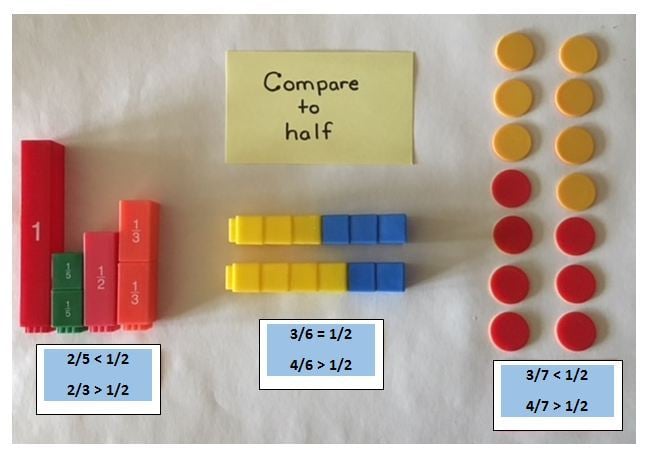
Continue reading →
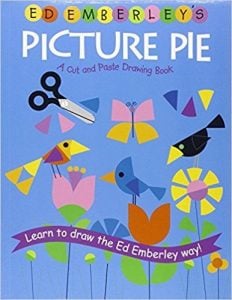 In this post I will share one project which helps students gain hands-on experience with fractions. More to come in future posts.
In this post I will share one project which helps students gain hands-on experience with fractions. More to come in future posts.


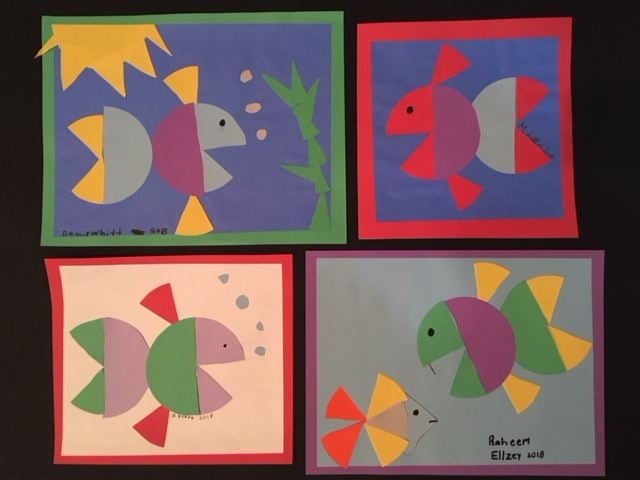

 In my opinion, determining if (or how) two fractions are equivalent is also a very important step when comparing fractions. However, regarding the OAS, students are not asked to represent or rename equivalent fractions until 4th grade (4.N.2.1). I will address equivalent fractions in the next post – just know that sometimes this skill goes hand in hand with comparing fractions. AND keep in mind that most of the standards for fractions through 4th grade stipulate “using concrete and pictorial models, fraction strips, number lines.” Students in 4th grade should not be expected to do abstract paper-pencil steps to simplify or “reduce” fractions to simplest terms, nor cross multiply to compare, etc. They need hands-on experience to more fully understand the concepts about fractions that are so difficult to grasp abstractly. Then in 5th grade students should have enough visual pictures in their head to solve operational problems with fractions. OK, that’s my soapbox. Don’t make it harder than it should be.
In my opinion, determining if (or how) two fractions are equivalent is also a very important step when comparing fractions. However, regarding the OAS, students are not asked to represent or rename equivalent fractions until 4th grade (4.N.2.1). I will address equivalent fractions in the next post – just know that sometimes this skill goes hand in hand with comparing fractions. AND keep in mind that most of the standards for fractions through 4th grade stipulate “using concrete and pictorial models, fraction strips, number lines.” Students in 4th grade should not be expected to do abstract paper-pencil steps to simplify or “reduce” fractions to simplest terms, nor cross multiply to compare, etc. They need hands-on experience to more fully understand the concepts about fractions that are so difficult to grasp abstractly. Then in 5th grade students should have enough visual pictures in their head to solve operational problems with fractions. OK, that’s my soapbox. Don’t make it harder than it should be.



